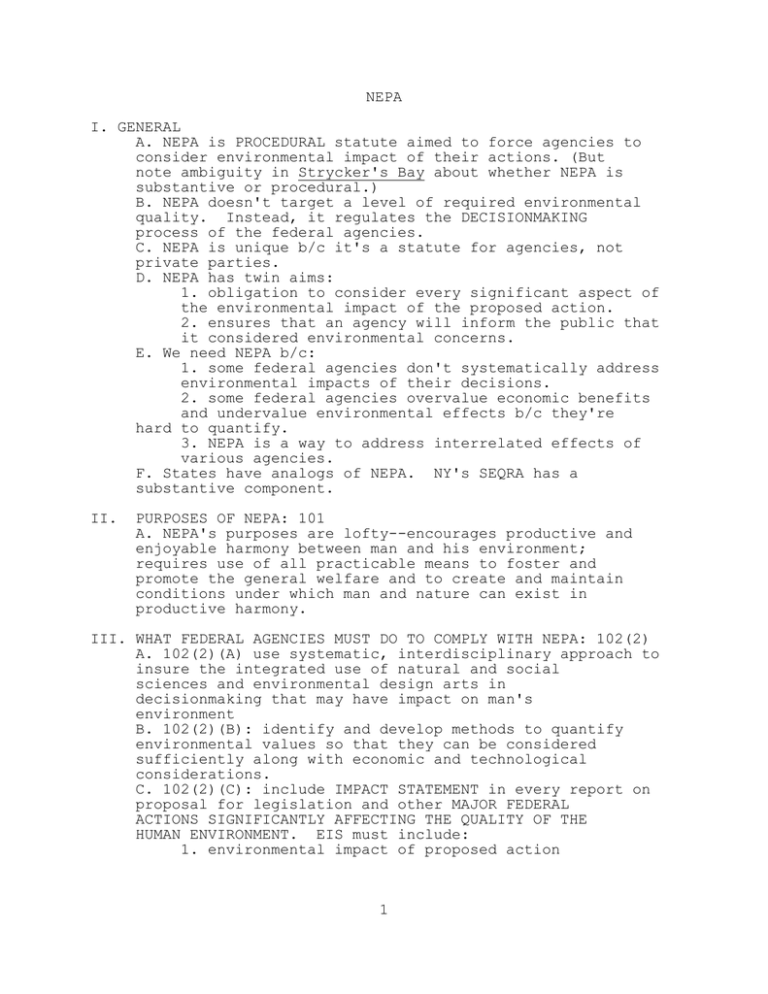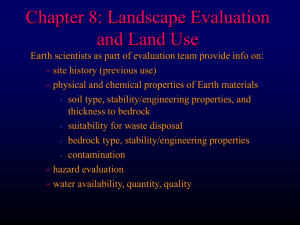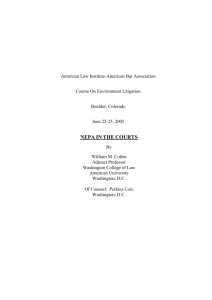NEPA I. GENERAL
advertisement

NEPA I. GENERAL A. NEPA is PROCEDURAL statute aimed to force agencies to consider environmental impact of their actions. (But note ambiguity in Strycker's Bay about whether NEPA is substantive or procedural.) B. NEPA doesn't target a level of required environmental quality. Instead, it regulates the DECISIONMAKING process of the federal agencies. C. NEPA is unique b/c it's a statute for agencies, not private parties. D. NEPA has twin aims: 1. obligation to consider every significant aspect of the environmental impact of the proposed action. 2. ensures that an agency will inform the public that it considered environmental concerns. E. We need NEPA b/c: 1. some federal agencies don't systematically address environmental impacts of their decisions. 2. some federal agencies overvalue economic benefits and undervalue environmental effects b/c they're hard to quantify. 3. NEPA is a way to address interrelated effects of various agencies. F. States have analogs of NEPA. NY's SEQRA has a substantive component. II. PURPOSES OF NEPA: 101 A. NEPA's purposes are lofty--encourages productive and enjoyable harmony between man and his environment; requires use of all practicable means to foster and promote the general welfare and to create and maintain conditions under which man and nature can exist in productive harmony. III. WHAT FEDERAL AGENCIES MUST DO TO COMPLY WITH NEPA: 102(2) A. 102(2)(A) use systematic, interdisciplinary approach to insure the integrated use of natural and social sciences and environmental design arts in decisionmaking that may have impact on man's environment B. 102(2)(B): identify and develop methods to quantify environmental values so that they can be considered sufficiently along with economic and technological considerations. C. 102(2)(C): include IMPACT STATEMENT in every report on proposal for legislation and other MAJOR FEDERAL ACTIONS SIGNIFICANTLY AFFECTING THE QUALITY OF THE HUMAN ENVIRONMENT. EIS must include: 1. environmental impact of proposed action 1 2. adverse environmental effects that cannot be avoided if project is implemented 3. alternatives to proposed action 4. relation between local short-term uses of man's environment and maintenance and enhancement of long-term productivity AND 5. irreversible and irretrievable commitments of resources which would be involved Before creating EIS, responsible official should contact other relevant federal agencies. Agency must make EIS and comments made by other agencies available to public. D. 102(2)(E): study and describe alternatives to courses of action in proposal which involve unresolved conflicts on use of resources 1. Note that this applies to projects which don't require EIS preparation, so no matter what, alternatives are considered. IV. PROCEDURAL REQUIREMENTS FOR COMPLYING WITH NEPA Calvert Cliffs 1. AEC proposed regulations to comply with NEPA but the regulations were held to violate statute. 2. AEC's policy was to consider environmental effects only if someone contested license. Ct held that decisonmaker MUST consider environmental effects at time license is made. (AEC must review EIS even if environmental problems were not affirmatively raised.) 3. AEC would not look at environmental effects if another agency had already certified that project complied with other agency's regulations. So NEPA applied only to those environmental issues wholly unregulated by any other government body. a. Ct held AEC must consider and balance environmental effects on a case-by-case basis b/c if AEC does balance, it can choose the environmentally best project from among several which all meet the environmental stds of other agencies. 4. AEC would not consider environmental effects until licensing stage for plants that had started construction before NEPA was enacted. Ct held AEC must consider environmental effects before construction. 5. So overall NEPA is procedural--ct requires environmental effects to be considered, but agency can review EIS without changing decisions and projects. V. WHAT IS A MAJOR FEDERAL ACTION: A. Federal action is not limited to wholly federal government involvement. B. Federal action if state and private actions require federal license and use federal funding. (Calvert 2 Cliffs) C. City of Boston v. Volpe: FAA tried to get around EIS requirement by permitting non-federal actor (Mass. Port Auth.) to arrange for environmentally damaging acts. Ct held that tentative allocation of funding by federal government for local project is not enough to be a federal action--must have a final decision on allocation of funds. In this situation, MPA got around NEPA by doing environmentally harmful things before receiving the actual funds which would officially federalize the project. D. Silva: Developer was enjoined from knocking down trees until HUD wrote EIS b/c ct found sufficiently close nexus between developer and HUD where HUD was providing mortgage guarantees. Note: City of Boston and Silva reached opposite conclusions on the same issue even though both are using intermediary non-federal actor. E. Direct federal appropriations for specific project federalizes the project. F. Block grants to state federalize project, but not if block grants are used only to create a plan of action. G. If federal government gives money generally and has no control over how money is used, that is not federal involvement. H. Hanley II Federal agency proposed to build prison in Manhattan using federal funds. 1. Ct held that in order to determine if EIS is necessary, agency should do an ENVIRONMENTAL ASSESSMENT (EA). This is a shorter, less detailed version of EIS which looks at same things. 2. Ct held that agency must give notice to public of proposed major federal action and opportunity to submit relevant facts which may bear on agency's threshold decision of whether they have to file EIS. 3. Dissent: EA is unduly burdensome. NEPA has no procedural requirement on agencies in making threshold determination of whether EIS is demanded. He thinks majority read this requirement into statute. VII. WHAT ARE EFFECTS SIGNIFICANTLY AFFECTING THE ENVIRONMENT? A. Because NEPA has a very broad view of what constitutes the human environment, including quality of life issues, can always argue that something significantly affects the environment. B. Hanley II 1. Hanley I held noise, crime, congestion and availability of drugs are recognizable effects under NEPA (quality of life considerations). 3 These fall under profound influences of highdensity urbanization and industrial expansion within 101(a). 2. Fear of increase in crime is NOT enough to trigger EIS preparation, but risk of increase is enough. C. 3 Mile Island Case: Ct held that psychological fear of damage to health is not enough to trigger EIS preparation. This is b/c non-physical effects can't be quantified. 1. But majority approach is that once EIS is required b/c of physical effects, non-physical effects must be considered also. D. Historical, cultural and archaeological effects of a major federal action mandate an EIS. E. Aesthetic effects do not mandate an EIS b/c they are subjective matters. F. Strycker's Bay: Ct has very broad view of what is an environmental consequence--concentration of low-income housing (as opposed to mix of low and mid-income housing) was what gave rise to this case. (Note that if it was a mix of low and mid-income housing no EIS would be required.) VIII. EXEMPTIONS FROM EIS REQUIREMENT A. Andrus: 1. Budget requests are not proposals for legislation b/c they fund already proposed actions and therefore do not require EIS. 2. Revesz says this is not a good argument but court was worried about burdening agencies by having to do new EIS every time budget done again. B. All actions under CAA and most under CWA are not major federal actions. C. All environmentally protective activities conducted by EPA don't require EIS b/c hearings are functional equivalent of EIS. D. EPA is exempt from preparing EIS when issuing permit under RCRA b/c EPA's express function is to consider environmental consequences and alternatives and therefore EIS is redundant. E. Emergencies F. If there is a clear and unavoidable conflict between existing statutory requirements and NEPA, no EIS is required. IX. THE LEAD AGENCY CONCEPT A. If more than 1 agency is involved in a project, 1 agency is designated as the lead agency and is responsible for preparing EIS. Other agencies can use this EIS for their own decisionmaking and to satisfy the courts. a. This is criticized b/c other agencies will disregard 4 lead agency's document. b. There are often disputes as to who should be leader. Cts won't hear these disputes b/c it's questionable if they are adverse parties (both are executive branch, so President can decide) B. If agencies can't reach agreement on who should be lead agency, CEQ regulations require 5 factors to be used to designate lead agency (in descending importance): 1. which agency is more involved in project 2. which agency has authority to approve or disapprove project 3. which agency has expertise concerning environmental effects 4. which agency is involved for longest time in project 5. which agency is involved first X. WHEN DO YOU NEED A COMPREHENSIVE EIS OR SEPARATE EISs? A. SEGMENTATION PROBLEM: Agencies try to avoid preparation of EIS for large project by breaking it down to small actions which don't rise to the level of "significant." 1. CEQ has special rules against segmentation-"connected actions" must be considered together in an EIS. Actions are "connected" if: a. they automatically trigger other actions which may require EIS b. cannot or will not proceed unless other actions are taken previously or simultaneously AND c. they are interdependent parts of a larger action and depend on the larger action for their justification B. Kleppe: 1. Sierra Club argued comprehensive EIS was required for further development of coal-mining operations on federal land in the Northern Great Plains. They claimed that coal operations threaten their enjoyment of region's environment and thus agency must do EIS before continuing. 2. Ct held a comprehensive EIS is necessary when several proposed actions that will have a cumulative or synergistic environmental impact on a region are pending concurrently before an agency. In this case, projects were not so linked as to require one EIS. 3. Ct also held that agencies must have EIS ready when they propose federal action (102(2)(C)), not at time of mere contemplation. XI. CONSIDERATION OF ALTERNATIVES A. 101(2)(C)(iii) requires agency to consider environmental alternatives. B. NRDC v. Morton: 5 1. Agency was to lease submerged federal lands off the coast of Louisiana for oil and gas production. EIS was done which showed adverse environmental effects, but agency approved sale anyway. 2. NRDC argued agency had to discuss environmental effects of alternatives, but agency argued that no such discussion was needed, only a statement of alternatives. 3. Ct held that 102(2)(C) requires agency to consider alternatives and evaluate the environmental impact of those alternatives. The statute doesn't explicitly say this, but otherwise considering alternatives is purposeless. 1. Must give information sufficient to permit reasoned choice of alternatives. 2. Agency can refer to other agencies' EIS. 3. Agency cannot disregard alternatives just b/c they don't offer a complete solution to the problem. 4. Agency must discuss alternatives even if they lay outside this agency's authority or if they require legislative implementation. 5. Note: This is a very broad expansive reading of what alternatives need to be considered and the extent to which they must be discussed. 6. Note: Revesz criticizes court--the requirement to look at alternatives only makes sense in comparing 2 similar programs or 2 sites for the same project but not when comparing totally different things (leasing land vs. oil import quotas) C. Vermont Yankee: 1. S. Ct. held that only feasible alternatives must be discussed--not alternatives which are remote or speculative. (threshold test) 2. Ct also held that intervenor must structure his participation to be meaningful especially when asking agency to do something new (i.e. look at alternative of energy conservation). Ct said intervenor should have further clarified his contentions. a. Revesz criticizes this opinion as being political--he feels that once an intervenor raises an issue during the comment period, the agency should go find out about it. 3. So must discuss alternatives which are in agency's area of expertise and alternatives brought up by others during the comment period with sufficient specificity. a. Revesz says requirement of specificity adds 6 substance to NEPA b/c it requires agency to consider the substance of the intervenor's comments. D. Strycker's Bay: 1. HUD and City Planning Commission planning to build low income housing on Upper West Side. This creates a great concentration of low income housing in the area. Community groups oppose b/c, although not required to do EIS under 102(2)(C) b/c not a major federal action, agency should consider alternatives under 102(2)(E). 2. 2d Cir. held HUD was wrong in saying that delay overrides concentration of low-income housing. Rather, concentration should override delay. 3. S. Ct. reversed 2d Cir. by saying that 2d Cir. was out of line telling the agency what to do. Reason in opinion is unclear. Either reason is b/c: a. Once agency considered environmental impact, no further judicial review is possible (i.e. NEPA is only procedural) OR b. Judicial review is possible using arbitrary and capricious std of Admin. Proc. Act. (NEPA is a substantive statute but here 2d Cir. got the substance wrong) 4. Note: Revesz says that whichever way we resolve the ambiguity, substantive review under NEPA is dead. Either: a. substantive review is so deferential that nothing is arbitrary and capricious. OR b. NEPA is only procedural. XII. CRITICISMS OF NEPA A. NEPA is brief and vague. B. Difficult for judicial review of NEPA if NEPA is substantive, b/c judge must decide which scientific facts/models to use. C. NEPA doesn't say what to do with an EIS once it is prepared--can do EIS showing bad environmental effects and then ignore it and go on with project. D. EIS becomes a political and not scientific statement b/c agency usually makes decision first and then justifies it with EIS. NEPA was supposed to force agencies to change the way they make decisions but it hasn't--it just makes the agency produce more paper. E. NEPA is used as a tool to challenge development. It allows challenges motivated by NIMBYism and not environmental reasons. It puts the cts in the land use 7 business. F. Often plaintiffs use NEPA to litigate just to buy time in hopes that project will fall through b/c of delay (b/c funding runs out or legislative measures prohibiting such development are enacted) G. EISs are usually done by outside consultants (who are inclined to prepare EIS favorably to agency) and not the agency itself. So it looks like an objective opinion but is not really. H. NEPA is not that effective b/c although Congress has all this language about harmony in the environment, it continues to fund projects regardless of their environmental effects. XIII. BENEFITS OF NEPA A. Stalls undesirable projects until they die, an alternative becomes more attractive or legislature passes an environmentally protective statute. B. Raises visibility of environmental concerns. C. Raises political pressure on officials not to do problematic projects. D. If agencies weren't required to gather info on environmental effects, transaction costs may be too high for public to gather it. People who want to oppose a siting may not have the information necessary to litigate. XIV. IF NOT NEPA, THEN WHAT WOULD BE A BETTER ALTERNATIVE? A. Perhaps cts should have more substantive review power. B. Perhaps a presidential council (CEQ? God-Squad style?) should have substantive review power. 8





